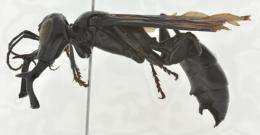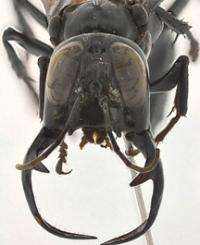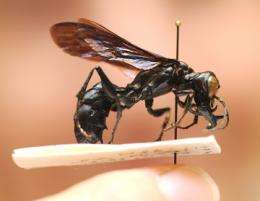Entomologist discovers new wasp species

(PhysOrg.com) -- A warrior wasp? A wasp with jaws longer than its front legs? The new species of wasp that Lynn Kimsey, director of the Bohart Museum of Entomology and professor of entomology at the University of California, Davis, discovered on the Indonesian island of Sulawesi, has scientists abuzz.
The jaw-dropping, shiny black wasp appears to be the "Komodo dragon" of the wasp family.
It's huge. The male measures about two-and-a-half-inches long, Kimsey said. "Its jaws are so large that they wrap up either side of the head when closed. When the jaws are open they are actually longer than the male's front legs. I don't know how it can walk. The females are smaller but still larger than other members of their subfamily, Larrinae."
Kimsey discovered the warrior wasp on the Mekongga Mountains in southeastern Sulawesi on a recent biodiversity expedition funded by a five-year grant from the International Cooperative Biodiversity Group Program.
The insect-eating predator belongs to the genus Dalara and family Crabronidae. "I'm going to name it Garuda, after the national symbol of Indonesia," Kimsey said. Garuda, a powerful mythical warrior that's part human and part eagle, boasts a large wingspan, martial prowess and breakneck speed.
"The first time I saw the wasp I knew it was something really unusual," said Kimsey, a noted wasp expert who oversees the Bohart Museum's global collection of 7 million insect specimens, including 500,000 wasps. "I'm very familiar with members of the wasp family Crabronidae that it belongs to but had never seen anything like this species of Dalara. We don't know anything about the biology of these wasps. They are only known from southwestern Sulawesi."
In her entire career as an entomologist, she's discovered close to 300 new species. But on three trips to Sulawesi, she's brought back to the Bohart Museum "hundreds, maybe thousands of new species."

"It will take years, maybe generations, to go through them all," Kimsey said.
"I consider Sulawesi one of the world's top three islands for biodiversity — that along with Australia and Madagascar."
Sulawsei, a large Indonesian island located between Borneo and New Guinea, is known not only for its endemic biodiversity, but its rainforest and its proximity (three degrees) to the equator. Development threatens plant and animal life.
On the last three-week expedition, the UC Davis team of Lynn Kimsey, husband Robert Kimsey, a forensic entomologist/adjunct professor in the UC Davis Department of Entomology, and Alan Hitch, assistant curator of the Museum of Wildlife and Fish Biology, met up with 12 scientists from the Indonesian Institute of Sciences (LIPI).
The 67-member expedition also included 12 members of Kendari's Chitaka mountaineering group, which guides mountain climbers to the top of the 9,117-foot volcanic peak; and a 40-member porter team that carried the equipment, set up camp and cooked the food, "which was steamed rice and ramen noodles three times a day," she said.
"Eventually we had to leave because we ran out of food."
The terrain was steep, slippery and physically challenging overall, Lynn Kimsey said. "This part of Sulawesi gets about 400 inches of rain a year," she said. "We were told that Sulawesi has a dry and rainy season. But the only difference we could see between the dry and rainy season is that during the dry season, it rains only in the afternoon."

Kimsey expressed amazed at the biodiversity of the flora and fauna. "We saw a colonial spider web that stretched across two acres. The adult spiders were about 2 inches long."
"We saw evidence of wild cows, anoa, found only in Sulawesi, and found the first record in that region of a (Sulawesi) palm civet, a weasel-like predator."
Over the last four years, the international team of scientists has collected about a million specimens. Among the new species: a bat, two frogs, two lizards, two fish, a land crab and many insects.
Kimsey is a collaborator of a five-year $4 million grant awarded to UC Davis scientists in 2008 to study the biodiversity of fungi, bacteria, plants, insects and vertebrates on Sulawesi, all considered threatened by logging operations and mining developments. Much of the mountain was logged two decades ago and now there are plans for an open pit nickel mine, Kimsey said.
"There's talk of forming a biosphere reserve to preserve this," she said. "There are so many rare and endangered species on Sulawesi that the world may never see."
An international team of collaborators is conducting biodiversity surveys, as well as screening microbes and plants for applications to human health and energy needs, recommending strategies to conserve endangered species, and developing and encouraging local conservation, according to principal investigator Daniel Potter of the UC Davis Department of Plant Sciences. Other collaborators from UC Davis are from the UC Davis Herbarium, Museum of Wildlife and Fish Biology, Plant Pathology and the Phaff Yeast Culture Collection in the Department of Food Science and Technology.
Shortly after receiving the grant, Potter, a plant systematist at the Agricultural Experiment Station and director of the UC Davis Center for Plant Diversity, said: "The alarming rate at which biodiversity is being lost in many tropical regions has resulted in an urgent need for such efforts."
Provided by UC Davis


















